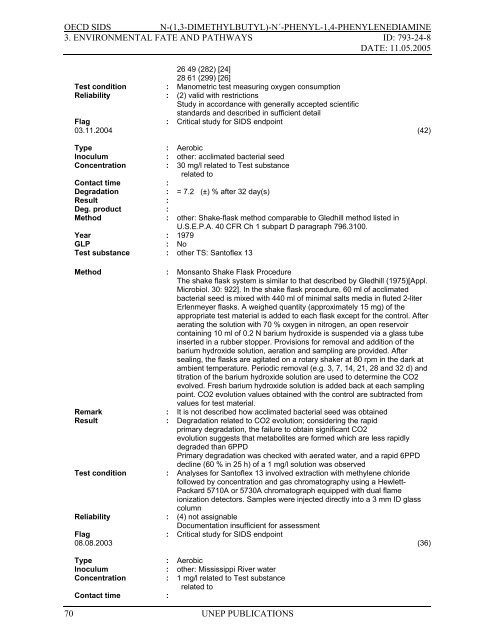N-(1,3-Dimethylbutyl)-N
N-(1,3-Dimethylbutyl)-N
N-(1,3-Dimethylbutyl)-N
You also want an ePaper? Increase the reach of your titles
YUMPU automatically turns print PDFs into web optimized ePapers that Google loves.
OECD SIDS<br />
N-(1,3-DIMETHYLBUTYL)-N´-PHENYL-1,4-PHENYLENEDIAMINE<br />
3. ENVIRONMENTAL FATE AND PATHWAYS ID: 793-24-8<br />
DATE: 11.05.2005<br />
26 49 (282) [24]<br />
28 61 (299) [26]<br />
Test condition : Manometric test measuring oxygen consumption<br />
Reliability : (2) valid with restrictions<br />
Study in accordance with generally accepted scientific<br />
standards and described in sufficient detail<br />
Flag : Critical study for SIDS endpoint<br />
03.11.2004 (42)<br />
Type : Aerobic<br />
Inoculum : other: acclimated bacterial seed<br />
Concentration : 30 mg/l related to Test substance<br />
related to<br />
Contact time :<br />
Degradation : = 7.2 (±) % after 32 day(s)<br />
Result :<br />
Deg. product :<br />
Method : other: Shake-flask method comparable to Gledhill method listed in<br />
U.S.E.P.A. 40 CFR Ch 1 subpart D paragraph 796.3100.<br />
Year : 1979<br />
GLP : No<br />
Test substance : other TS: Santoflex 13<br />
Method : Monsanto Shake Flask Procedure<br />
The shake flask system is similar to that described by Gledhill (1975)[Appl.<br />
Microbiol. 30: 922]. In the shake flask procedure, 60 ml of acclimated<br />
bacterial seed is mixed with 440 ml of minimal salts media in fluted 2-liter<br />
Erlenmeyer flasks. A weighed quantity (approximately 15 mg) of the<br />
appropriate test material is added to each flask except for the control. After<br />
aerating the solution with 70 % oxygen in nitrogen, an open reservoir<br />
containing 10 ml of 0.2 N barium hydroxide is suspended via a glass tube<br />
inserted in a rubber stopper. Provisions for removal and addition of the<br />
barium hydroxide solution, aeration and sampling are provided. After<br />
sealing, the flasks are agitated on a rotary shaker at 80 rpm in the dark at<br />
ambient temperature. Periodic removal (e.g. 3, 7, 14, 21, 28 and 32 d) and<br />
titration of the barium hydroxide solution are used to determine the CO2<br />
evolved. Fresh barium hydroxide solution is added back at each sampling<br />
point. CO2 evolution values obtained with the control are subtracted from<br />
values for test material.<br />
Remark : It is not described how acclimated bacterial seed was obtained<br />
Result : Degradation related to CO2 evolution; considering the rapid<br />
primary degradation, the failure to obtain significant CO2<br />
evolution suggests that metabolites are formed which are less rapidly<br />
degraded than 6PPD<br />
Primary degradation was checked with aerated water, and a rapid 6PPD<br />
decline (60 % in 25 h) of a 1 mg/l solution was observed<br />
Test condition : Analyses for Santoflex 13 involved extraction with methylene chloride<br />
followed by concentration and gas chromatography using a Hewlett-<br />
Packard 5710A or 5730A chromatograph equipped with dual flame<br />
ionization detectors. Samples were injected directly into a 3 mm ID glass<br />
column<br />
Reliability : (4) not assignable<br />
Documentation insufficient for assessment<br />
Flag : Critical study for SIDS endpoint<br />
08.08.2003 (36)<br />
Type : Aerobic<br />
Inoculum : other: Mississippi River water<br />
Concentration : 1 mg/l related to Test substance<br />
related to<br />
Contact time :<br />
70<br />
UNEP PUBLICATIONS
















